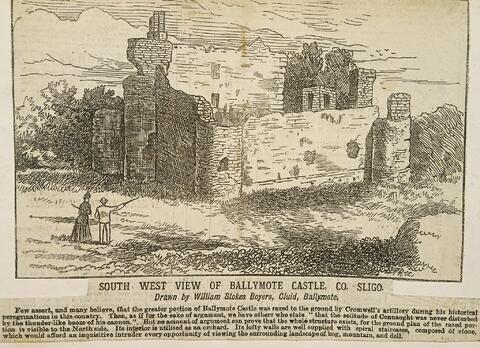Código de referencia
Título
Fecha(s)
- c.1895 (Creación)
Nivel de descripción
Volumen y soporte
1 p.; clipping
Nombre del productor
Institución archivística
Historia archivística
Origen del ingreso o transferencia
Alcance y contenido
A clipping of an article on Ballymote Castle in County Sligo. The drawing is by William Stokes Boyers.
Valorización, destrucción y programación
Acumulaciones
Sistema de arreglo
Condiciones de acceso
Condiciones
Idioma del material
Escritura del material
Notas sobre las lenguas y escrituras
Características físicas y requisitos técnicos
Instrumentos de descripción
Existencia y localización de originales
Existencia y localización de copias
Unidades de descripción relacionadas
Notas
Built in the late twelfth century, the castle is an impressive Anglo-Norman fortification and one of the strongest fortresses of its era constructed in Connacht. It is believed to have been built by Richard de Burgh (c.1259-1326), 2nd Earl of Ulster, a friend of King Edward I (Edward Longshanks) of England, and one of the most powerful Norman lords of the period. As alluded to in the original caption, the castle has had a varied history of attack and destruction, changing hands several times between Gaelic clans and English forces.
It was from Ballymote that Aodh Ruadh Ó Domhnaill (Red Hugh O’Donnell) marched to the disastrous Battle of Kinsale in late 1601. It was subsequently surrendered to the victorious Crown forces under Charles Blount (Lord Mountjoy). In the seventeenth century, the castle was subjected to yet more military assaults and was finally abandoned in the 1690s. Over time, it fell into complete ruin. Ballymote Castle is now a designated national monument and is maintained by the Office of Public Works.

